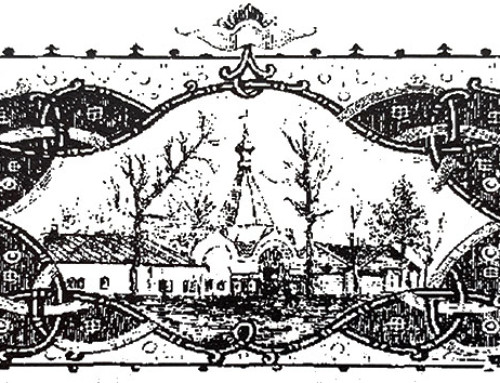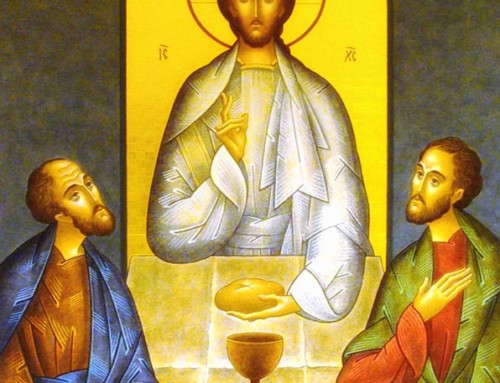Catechetical Sermon on the Divine Liturgy
#13 –The Water from the Side of Christ
Adding water to wine was a widespread habit in the Greco-Roman world, even among Jews. The first mention of adding hot water to the Cup in the Liturgy is very old, coming in sixth century Byzantium. Needless to say, adding hot water to the chalice was not necessitated by the chalice freezing—not something likely in a Mediterranean climate–it was simply a matter of taste, like putting sugar and cream in coffee, until the liturgical commentators latched onto it in the eleventh century when they saw it as an image of the side of Christ being opened by a spear with blood and water coming out. After the pouring of the zeon/teplota, the clergy at the Holy Table receive a portion of the Holy Bread and recited a prayer for personal preparation before consuming the Gift. After consuming the Bread they return to drink from the Cup.
From this point to the end of the service there is a very wide variety in all the prayers that accompany these actions between the various recensions (local editions of the text) in the Byzantine Church. And since the time between the elevation of the Bread and the actual distribution to the congregation is now noticeably longer than it used to be (due in part, as said above) to the addition of Scriptural verses and prayers as the various tasks of breaking the Bread, mixing the Cup–both with the hot water and then the Bread itself–setting aside the dish and replacing the cover(s) on the Cup, as well as reciting votive prayers, a second invitation to Communion was needed. The lead priest hands the mixed Cup to the deacon who takes it to the center of the royal doors and exclaims, “With fear of God and with faith, approach!” And since the original communion psalm has been drastically reduced, other chants were incorporated during the distribution to the people, usually popular hymns today.
The question arises, why does the deacon invite the people to Communion this second time, and not the presiding priest who gave the first invitation with his exclamation, “Holy Things for the holy”? At this point the deacon (or the priest if there is no deacon) is technically not inviting people to Communion, but simply signaling the beginning of the distribution to the laity (notice that the clergy have already received Communion), in line with the deacon’s responsibility to keep order as reflected in his lines, “Let us pray to the Lord,” or “Stand aright;” or as here, “Approach!” The deacon is probably holding the Cup because, in an earlier era, before the present practice of mixing the Holy Bread into the Cup of Wine came about, the people received Holy Communion under both forms separately–the bishop or presiding priest handing out the Bread and the deacon offering the Cup to the people for their participation.
Катехетична Проповідь про Божественну Літургію
#13 Вода, що витікає з Боку Христа
Практика додавання води до вина стала поширеною в греко-римському світі, навіть серед євреїв. Перша згадка про додавання гарячої води до Чаші на Літургії є дуже давня та походить з Візантії з VI століття. Зрозуміло, що додавання гарячої води до Чаші не було викликане фактом заморожування чаші, що не було характерним у Середземноморському кліматі, це було просто справою смаку, як, наприклад, додавання до кави цукру та крему, доки літургісти не звернули на це увагу в одинадцятому столітті, коли вони бачили у цьому образ проколеного списом боку Христа, з якого вийшла кров та вода. Після вливання теплоти, священики отримують частину Святого Хліба біля Престолу та читають молитву перед Св. Причастям. Після споживання Хліба, вони підходять, щоб пити з Чаші.
З цього моменту до завершення богослуження існують різні молитви, які супроводжують ці дії у різних виданнях тексту у Візантійській Церкві. Оскільки, час між піднесенням Хліба та уділенням його вірним є зараз помітно довшим, ніж раніше. Адже після додавання частин Св. Письма і молитов, розламування Хліба, додавання гарячої води до Чаші, а потім самого Хліба – відкладався дискос і Чашу накривалося, та промовлялися молитви, і священики закликали вірних приступати до Св. Причастя. Священик, який очолює богослуження, передає Чашу диякону, який підходить до центру царських дверей і промовляє: “З страхом Божим і з вірою, приступіть!” І, оскільки, первісний псалом був надто короткий, співалися інші пісні під час Причастя вірних, які належать, як правило, до популярних гімнів сьогодні.
Виникає питання, чому диякон запрошує людей до Причастя другий раз, а не головний священик, який виголосив перше запрошення з вигуком «Святеє святим»? На цьому етапі диякон (або священик, якщо немає диякона) технічно не запрошує людей до Причастя, а просто оголошує про початок уділення мирянам Св. Причастя (зверніть увагу, що духовенство вже отримало Причастя), відповідальністю диякона є підтримувати порядок, як це він виголошує словами: «Господу помолімся» або «Станьмо гідно», або як тут: «Підійди». Диякон, мабуть, тримає Чашу, тому що в ранній час задовго до звичаю змішування Святого Хліба у Чаші з вином, люди приймали Святе Причастя під двома видами окремо – єпископ або головний священик, який роздавав частиці Хліба та диякон підносив до уст вірних Чашу.



